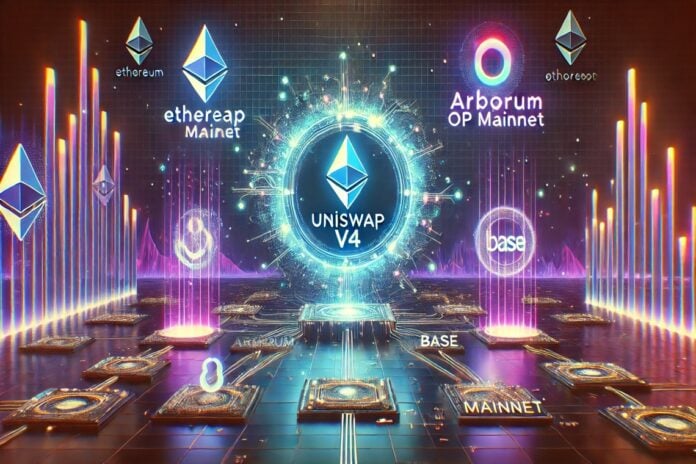Uniswap Labs has officially launched Uniswap v4, marking a significant step in the ongoing evolution of the DeFi protocol.
Operational on blockchains like Ethereum, Arbitrum, OP Mainnet, and Base, this new version introduces design innovations that promise to expand possibilities for developers and users.
In this article, we will explore the main features of Uniswap v4, with a focus on the introduction of “hook” and their impact on the DeFi ecosystem.
Summary
Uniswap v4: now available on more blockchain networks thanks to Uniswap Labs
The launch of Uniswap v4 represents an important expansion for the protocol. The platform is already operational on Ethereum, Arbitrum, OP Mainnet, and Base, allowing users to start providing liquidity immediately.
The swaps, one of the key functions of the protocol, will be available in the coming days, thus completing the implementation of the main features.
This interoperability between different blockchains highlights Uniswap’s ongoing focus on a multi-chain ecosystem, which aims to offer greater flexibility and scalability to users.
Accessibility across multiple networks allows liquidity providers to optimize their strategies, leveraging the unique advantages of each blockchain.
For example, Ethereum offers security and decentralization, while Arbitrum and OP Mainnet ensure reduced transaction costs and faster confirmation times.
The availability on Base, a Layer 2 blockchain developed on Ethereum, further underscores Uniswap’s commitment to supporting scalable solutions.
The distinctive feature of Uniswap v4 is the introduction of “hook”, a new functionality that transforms the protocol into a true development platform.
Hooks are smart contracts that allow developers to customize the behavior of swap liquidity pools and fees.
This innovation allows for the creation of tailored experiences for different use cases, increasing the versatility of the protocol.
For example, a pool could implement a hook to adjust fees based on market volatility, incentivizing liquidity during times of greater need.
Alternatively, developers could configure swaps that trigger specific actions, such as executing conditional orders or the automatic management of positions.
Thanks to the hooks, Uniswap is no longer just a tool for decentralized trading, but becomes a modular platform and flexible for building innovative DeFi solutions.
What do the hook mean for the liquidity provider?
For the liquidity providers, the hooks represent an opportunity to manage their positions more dynamically. For example, a hook could be used to create pools that self-regulate, automatically adapting to market changes.
This type of customization could reduce the risk of impermanent loss, one of the main challenges for those providing liquidity in AMM (Automated Market Maker) protocols.
Furthermore, hooks could facilitate the implementation of advanced strategies, such as algorithmic trading or automated management of commissions.
Developers will also have the opportunity to create customized pools that attract specific types of users, increasing the diversification of options available in the protocol.
The introduction of hooks transforms Uniswap from a simple exchange protocol to a modular platform for the development of DeFi applications.
This change opens the door to a range of creative possibilities for developers, who can now build custom applications directly on top of the protocol.
For example, a team of developers could create an application that uses hooks to implement a reward system based on the performance of liquidity providers.
Another use case could be the creation of specialized pools for illiquid assets, where the hooks automatically adjust the pool parameters to adapt to market conditions.
Uniswap v4: innovation and interoperability
With Uniswap v4, Uniswap Labs demonstrates its commitment to expanding the boundaries of innovation in the DeFi sector. The availability on multiple blockchain networks and the introduction of hooks mark a step forward towards a more flexible and accessible ecosystem.
Developers and liquidity providers can now leverage a more customizable platform, paving the way for a new generation of DeFi applications.
In conclusion, the launch of Uniswap v4 represents an example of how DeFi protocols can evolve to meet the needs of an increasingly diverse and sophisticated community.
With the implementation of hooks, Uniswap not only expands its functionalities, but positions itself as a key tool for the creation of innovative solutions in the blockchain ecosystem.

